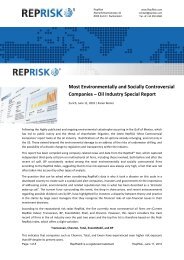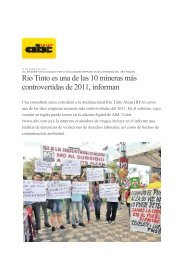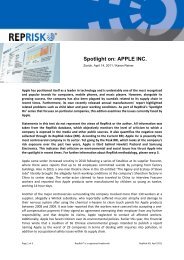Download report - RepRisk
Download report - RepRisk
Download report - RepRisk
Create successful ePaper yourself
Turn your PDF publications into a flip-book with our unique Google optimized e-Paper software.
In China, Gap was among a number of clothing retailers linked to environmental violations at supplier facilities<br />
in a <strong>report</strong> entitled ‘Cleaning up the Fashion Industry.’ According to the <strong>report</strong>, the country’s textile industry<br />
produces up to 2.5 billion tons of wastewater and other harmful pollutants every year, most of which end up<br />
in China’s water bodies, soil, and groundwater. In 2011 and 2012, NGOs highlighted serious risks associated<br />
with manufacturing in Bangladesh. The Clean Clothes Campaign <strong>report</strong>ed that Gap, together with H&M, is one<br />
of the largest buyers in the country and must take responsibility for improving the poverty wages. The country<br />
apparently boasts the lowest pay in the world, the weakest regulation, and the worst attention to workplace<br />
safety. This has <strong>report</strong>edly resulted in the death of almost 500 garment factory workers over the past 5 years.<br />
A 2010 fire killed 29 people in a Hameem Group factory supplying to major brands such as Gap. Most of the<br />
victims were women earning less than USD 2 per day.<br />
The tragedy was caused by unsafe conditions at the factory including an electric wiring overload that sparked<br />
the flame and a lack of fire escapes. Managers had allegedly locked the factory doors, meaning the workers<br />
were trapped inside. In December 2011, a boiler explosion at a Eurotex garment factory in Dhaka, which<br />
<strong>report</strong>edly supplies to Gap, resulted in the deaths of two workers and caused severe injuries to a further 62.<br />
Several months later, NGO War on Want <strong>report</strong>ed that Gap would take responsibility for the incident and offer<br />
compensation and treatment to victims and their families.<br />
While international companies have stated their willingness to establish a fire safety program and made some<br />
efforts to do so, the working environment has allegedly not improved. Most recently, Gap was linked to Tazreen<br />
Fashions’ garment factory, where a November 2012 blaze killed at least 111 workers and injured dozens<br />
more. Over the past few years, Gap has also been linked to poor conditions at facilities in Central America. In<br />
Honduras, it was accused of sourcing clothes from ‘maquilas’ – large industrial sweatshops where labor laws<br />
and worker rights are <strong>report</strong>edly often ignored. Factory employees allegedly earn less than a living wage and<br />
are forced to do overtime to make up for the work hours lost due to a government-imposed curfew in the wake<br />
of the 2009 military coup. In El Salvador, a similar situation <strong>report</strong>edly existed at Ocean Sky factories, with<br />
claims that Gap was one of the companies sourcing from them.<br />
In Mexico, the company was named in a Greenpeace <strong>report</strong>, published in late 2012, as one of the international<br />
retailers sourcing from a Kaltex facility, accused of discharging toxic chemicals and wastewater into water<br />
bodies. The NGO urged all companies mentioned to take action to ensure their suppliers do not pollute.<br />
In November 2012, Greenpeace released another <strong>report</strong>, ‘Toxic Threads,’ which accused 20 global brands,<br />
including Gap, M&S, Esprit and Nike, of manufacturing clothing containing toxic chemicals that polluted<br />
waterways and endangered human health, the environment and wildlife.<br />
It appears that the issues<br />
faced by Gap and its peers<br />
in terms of labor rights and<br />
environmental damage<br />
in the companies’ supply<br />
chains are ongoing and<br />
occur on a global scale.<br />
Such issues continue<br />
to plague high-profile<br />
fashion multinationals and<br />
impact negatively on their<br />
reputation. The question<br />
of how risky this is for their<br />
operations with respect to<br />
business continuity, public<br />
backlash, and government<br />
regulation, remains to be<br />
answered.<br />
<strong>RepRisk</strong>® is a registered trademark <strong>RepRisk</strong> AG, March 2013 3 of 4











